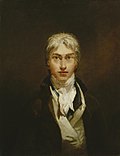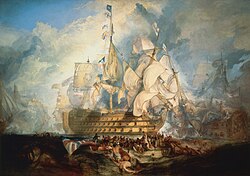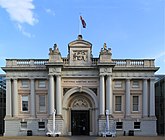Fil:The Battle of Trafalgar, 21 October 1805 RMG BHC0565.tiff

Originalfil (7 200 × 5 093 pixlar, filstorlek: 104,91 Mbyte, MIME-typ: image/tiff)
| Denna fil tillhandahålls av Wikimedia Commons. Informationen nedan är kopierad från dess filbeskrivningssida. |
Sammanfattning
| William Turner: Slaget vid Trafalgar 21 oktober 1805
|
|||||||||||||||||||||||||||
|---|---|---|---|---|---|---|---|---|---|---|---|---|---|---|---|---|---|---|---|---|---|---|---|---|---|---|---|
| Konstnär/skapare |
|
||||||||||||||||||||||||||
| Titel |
Slaget vid Trafalgar 21 oktober 1805 label QS:Les,"La Batalla de Trafalgar"
label QS:Lfr,"La Bataille de Trafalgar"
label QS:Lca,"La Batalla de Trafalgar"
label QS:Lde,"Die Seeschlacht von Trafalgar am 21. Oktober 1805"
label QS:Lsq,"Beteja e Trafalgarit (pikturë)"
label QS:Lzh,"特拉法加海戰"
label QS:Lda,"The Battle of Trafalgar"
label QS:Lja,"トラファルガーの海戦 (ターナー)"
label QS:Larz,"معركه الطرف الاغر"
label QS:Lpl,"Bitwa pod Trafalgarem"
label QS:Luk,"Трафальгарська битва"
label QS:Lnl,"The Battle of Trafalgar"
label QS:Lsv,"Slaget vid Trafalgar 21 oktober 1805"
label QS:Lel,"Η Μάχη του Τραφάλγκαρ"
label QS:Lhe,"קרב טרפלגר"
label QS:Lit,"La battaglia di Trafalgar"
label QS:Lar,"معركة الطرف الأغر" |
||||||||||||||||||||||||||
| Objekttyp |
målning object_type QS:P31,Q3305213 |
||||||||||||||||||||||||||
| Genre |
historiemåleri |
||||||||||||||||||||||||||
| Beskrivning |
English: The Battle of Trafalgar, 21 October 1805 This is Turner’s only work by ‘royal command’ and the largest and most publicly controversial painting of his career. George IV gave him the commission late in 1822 on the advice of Sir Thomas Lawrence, President of the Royal Academy. It was to form a naval pair with Philippe-Jacques de Loutherbourg’s 1795 view of The Battle of the Glorious First of June 1794, in a patriotic post-war redecoration of the State Rooms at St James’s Palace. Lawrence and George Jones – both Turner’s friends – were also represented, the former by his portrait of King George III and the latter by paintings of Wellington’s victories at Vittoria and Waterloo. Turner did an unusual amount of practical research for this work, which is his most complex tribute to Nelson, of whom he was a great admirer. He already had sketches of 'Victory', made on her return to England with Nelson’s body in December 1805 for his earlier 'The Battle of Trafalgar', painted in 1806-08. For this picture he borrowed a plan of the ship from the Admiralty and asked the marine artist J. C. Schetky, at Portsmouth, to make further sketches of her there. Also unusually, he did two preparatory oil studies (now in the Tate). The finished work combines a number of incidents from different times in the action, within a more symbolic conception. Nelson’s presence, mortally wounded, is only implied in the highlighted crowd around 'Victory’s' mainmast. This powerful absence is prefigured by the smallness of Nelson’s figure, and those around him, beneath similarly towering masts, in the 1806-08 picture. The small human scale is also a response to de Loutherbourg’s painting, since both in different ways contrast a mass of vulnerable figures with the great floating fortresses in which they are contesting national dominance on a mutually hostile sea. In 'The Harbours of England' (1856, p. 16) Ruskin grasped this elemental component when he likened the uncontrollability of the ship’s sails, as Turner shows them, to ‘as many thunderclouds’, most of 'Victory’s' falling with her foremast and at the same time as Nelson. Also symbolically, the falling mast bears his white vice-admiral’s flag, while the code flags spelling ‘d-u-t-y’ – both the last word of his famous Trafalgar signal and the last coherent thought he spoke (‘Thank God I have done my duty’) – are coming down from the mainmast. On the right is the French 'Redoutable', from which Nelson was shot, surrendered and sinking, although she in fact went down in the storm after the battle. British seamen in the foreground boats raise a cheer, unaware of the tragedy behind in 'Victory', herself shown on an exaggerated scale as a dominating symbol of British sea power. Other men try to save friends and foes alike from a darkly heaving sea, in which a tangle of floating rigging resembles a monster’s head and a Union flag is spread out above, as if to cover the fallen. Below the surface loom fragments of Nelson’s motto, ‘Palmam qui meruit ferat’. This can translate as ‘Let him who has earned it bear the Palm’, or, in the circumstances, ‘the price of glory is death’. That the cost is equal for the common sailor as much as the admiral is thrust into the viewer’s face by the dead seaman arching out backwards from the picture plane, in the centre, at what would have been original eye level in St James’s Palace. In imposing recession beyond 'Victory' on the left are the Spanish four-decker 'Santissima Trinidad' and the 'Bucentaure', flagship of Admiral Villeneuve, overall commander of the enemy Combined Fleet. Further left, the French 'Achille', 74 guns, is on fire with the bow of the 'Neptune' just coming into the frame. Her sister the 'Fighting Temeraire' , as Turner called her in his famous picture of 1839 is on the far right, lost in smoke apart from her white ensign. On delivery in 1824 the painting provoked court criticism for its non-chronological approach to Nelson’s victory, and its powerful allusions to the blood price of Britain’s triumph, at Trafalgar and more generally in becoming the world’s dominant sea power. Ambassadors used to classically heroic treatments are said to have sneered at it and seamen, including Sir Thomas Hardy, 'Victory’s' captain, have always criticized it on technical grounds. Turner himself later considered the picture spoilt by the eleven unpaid days that he spent at St James’s adjusting it to the views of Admiralty men and he credited the King’s naval brother, the Duke of Clarence (William IV from 1830), with the only sensible comments, despite a sharp exchange with him at the time. While George IV, when Prince of Wales, had acquired the cooler and more conventionally theatrical de Loutherbourg in Carlton House, Turner’s fierily spectacular but ambivalent pendant proved an embarrassment at St James’s. It was also probably mismatched there – at least to the King’s polished taste – with the adjacent works by Jones and his favourite portraitist, Lawrence. In late 1829 he presented it, with the de Loutherbourg, as his final gifts to the Naval Gallery at Greenwich Hospital. It has been at Greenwich ever since, and remains to some extent a focus of recurring division between ‘sea dogs’ and art historians, admirers of Nelson and of Turner. |
||||||||||||||||||||||||||
| Datum | 1822 | ||||||||||||||||||||||||||
| Teknik/material |
olja på kanvas |
||||||||||||||||||||||||||
| Mått | Painting: 2615 x 3685 mm; Frame: 3086 mm x 4179 mm x 195 mm | ||||||||||||||||||||||||||
| Samling |
institution QS:P195,Q7374509 |
||||||||||||||||||||||||||
| Placering | |||||||||||||||||||||||||||
| Inventarienummer |
BHC0565 |
||||||||||||||||||||||||||
| Referenser | |||||||||||||||||||||||||||
| Källa/fotograf | http://collections.rmg.co.uk/collections/objects/12057 | ||||||||||||||||||||||||||
| Tillstånd (Återanvändning av denna fil) |
The original artefact or artwork has been assessed as public domain by age, and faithful reproductions of the two dimensional work are also public domain. No permission is required for reuse for any purpose. The text of this image record has been derived from the Royal Museums Greenwich catalogue and image metadata. Individual data and facts such as date, author and title are not copyrightable, but reuse of longer descriptive text from the catalogue may not be considered fair use. Reuse of the text must be attributed to the "National Maritime Museum, Greenwich, London" and a Creative Commons CC-BY-NC-SA-3.0 license may apply if not rewritten. Refer to Royal Museums Greenwich copyright. |
||||||||||||||||||||||||||
| Andra versioner |
|
||||||||||||||||||||||||||
| Identifier InfoField | Greenwich Hospital Collection number: GH98 Loan File Number: Y2000.023 file number: 4G10.031 id number: BHC0565 |
||||||||||||||||||||||||||
| Collection InfoField | Oil paintings | ||||||||||||||||||||||||||
Licensiering
|
Denna bild utgör en verklighetstrogen avbildning av ett tvådimensionellt konstverk. Det avbildade verket är upphovsrättsligt fritt av följande skäl:
Wikimedia Foundation anser att även verklighetstrogna reproduktioner av upphovsrättsligt fria tvådimensionella konstverk är fria.
Denna fotografiska reproduktion anses därför vara upphovsrättsligt fri i USA. Andra länders lagstiftning kan eventuellt begränsa möjligheten att använda bilden. För mer information, se Commons:Reuse of PD-Art photographs. | |||||
Bildtexter
Objekt som porträtteras i den här filen
motiv
Filhistorik
Klicka på ett datum/klockslag för att se filen som den såg ut då.
| Datum/Tid | Miniatyrbild | Dimensioner | Användare | Kommentar | |
|---|---|---|---|---|---|
| nuvarande | 1 oktober 2017 kl. 22.24 |  | 7 200 × 5 093 (104,91 Mbyte) | Fæ | Royal Museums Greenwich Oil paintings (1822), http://collections.rmg.co.uk/collections/objects/12057 #2002-2 |
Filanvändning
Följande 2 sidor använder den här filen:
Global filanvändning
Följande andra wikier använder denna fil:
- Användande på en.wiki.x.io
Metadata
Den här filen innehåller extrainformation som troligen lades till av en digitalkamera eller skanner när filen skapades. Om filen har modifierats kan det hända att vissa detaljer inte överensstämmer med den modifierade filen.
| Bredd | 7 200 px |
|---|---|
| Höjd | 5 093 px |
| Bitar per komponent |
|
| Komprimeringsalgoritm | Inte komprimerad |
| Pixelsammansättning | RGB |
| Offset till bilddata | 140 |
| Antal komponenter | 3 |
| Antal rader per strip | 5 093 |
| Byte per komprimerad strip | 110 008 800 |
| Dataarrangemang | chunkformat |




